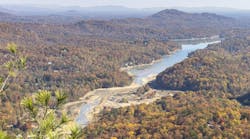About the author: Rebecca Kauten, CPESC-IT, MPP, is secretary of the Great Rivers Chapter of IECA and works on water quality monitoring projects through a partnership between the Iowa Department of Natural Resources and the University of Northern Iowa. Kauten can be reached at [email protected].
Anyone driving through Iowa last spring was likely to see plenty of water across the landscape. As drivers and residents alike make use of Iowa roadways, it is important to keep in mind the function of the right-of-way system, especially during severe storm events. Both “hard armor” structures and the “soft armor” of native plant communities serve a purpose during these times.
Culverts help divert roadway runoff and reduce erosion to road beds, ditches and banks. Strategically placed culverts can help maintain a stable velocity and proper flow of runoff through road ditches by controlling the rate of release. According to the “Local Roads Maintenance Worker’s Manual” (Center for Transportation Research, Iowa State University), water on or under the roadway is the single most significant cause of damage to the roadway. Therefore, it is critical to manage runoff in a way that minimizes damage to the road. When heavy rains occur, however, culverts also can be disguised under high water that appears to be still. During heavy rain events—similar to what Iowa experienced this past fall—ditch culverts can move water through the drainage system at a high rate.
Anyone working on, playing in or accessing areas near ditch culverts with high standing water should proceed with caution. While the water may appear to be stable on its surface, the drainage system below is still performing, creating an undertow effect. Especially large storms can turn ditch bottoms into temporary water features on the landscape. While things may look calm on the surface, water is still moving below.
In many instances, standing water above culverts can indicate debris or sediment clogs; however, heavy, intense rainfall can overwhelm drainage systems designed to manage smaller capacities. These larger storm events also can create significant erosion and sedimentation problems in areas with poor vegetation or in plant communities with shallow root systems. Integrated roadside vegetation management programs, particularly those that incorporate native grasses
and forbs in roadside seeding mixes, can successfully manage this erosion. Instead of losing topsoil and vegetation to fast-flowing water, the deep roots of native plants hold the soil in place and withstand the brute force of the storm.
In July 2011, Dubuque County experienced almost 15 in. of rainfall in just a few hours. Streams and roadsides were quickly overwhelmed. The intense storm surge sent trees toppling and scoured turfgrass to bare soil. Conversely, a three-year-old prairie planting withstood the deluge with minimal impact. Inspection of the area one week after the storm event indicated that the deeper root systems stayed intact better than turf. In many instances, debris that wrapped around trees aided the downstream erosion. In the areas planted with native vegetation, debris still wrapped around trees, but had significantly less impact on soil erosion.
With seasonal weather on the way, it is important to stay mindful of the systems in place for drainage, as well as ways to minimize damages from major storm events. In most instances, culverts continue to drain, even in high water. And as we experience flooding and extreme rainfall events, it is worth noting the value of native vegetation as a preventive measure against erosion and sedimentation after the fact.
Download: Here

